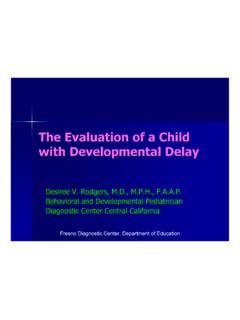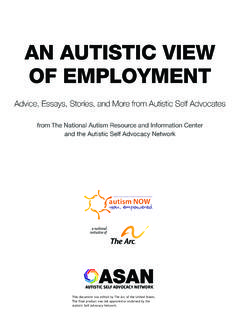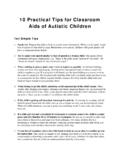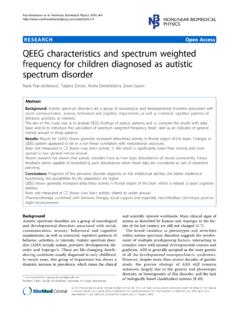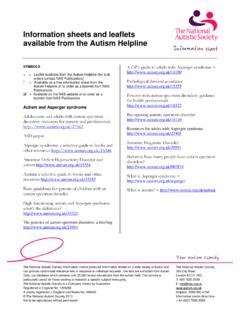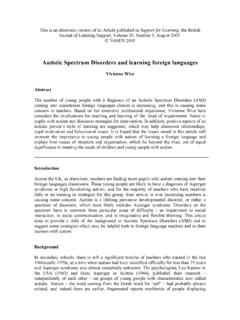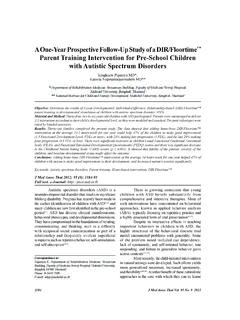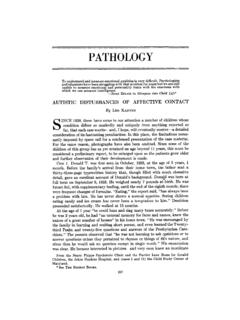Transcription of Overview: Neuropsychological Evaluation of Autistic ...
1 overview : Neuropsychological Evaluation ofAutistic Spectrum DisorderAutistic Spectrum DisorderHoward Glidden, FACPNN europsychological Assessment Neuropsychology is a subspeciality of psychology that blends the disciplines of psychology and neuroscience. APA definition of Pediatric Neuropsychology: Pediatric neuropsychology is a professional APA definition of Pediatric Neuropsychology: Pediatric neuropsychology is a professional specialty concerned with learning and behavior in relationship to a child s brain. A pediatric neuropsychologist is a licensed psychologist with expertise in how learning and behavior are associated with the development of brain structures and Purpose of Pediatric neuropsychology To clarify the diagnosis/differential diagnosis To establish a baseline of functioning To evaluate relative strengths/weaknesses To evaluate change over time To assist in treatment/educational planning To assist in treatment/educational planning To facilitate the therapy itself Psychological/ Neuropsychological
2 Evaluations differ from medical classification of brain functions which is usually binary (normal/impaired). Neuropsychological assessment can grade function based on a continuum. Neuropsychological assessment allows for increased principles of assessment No single psychometric test is sufficient or appropriate, by itself, for assessing brain function/dysfunction Assessment, in addition to psychometric test administration, takes into account: Developmental history Developmental history Family history Previous assessments Cultural/language variability Limits of reliability/validity of instruments utilized Test bias There may be many reasons why a client performs poorly on a test or group of tests, which affects reliabilityAll measures, whether they be observation, clinical interview, psychometric or radiologic/lab tests provide estimates of the trait being measure.
3 There are no perfect tests There are no perfect tests Tests are predictive of a trait or attribute being considered Tests yield scores that indicate the degree to which the trait in question is present In general, the higher the score, the greater the amount of the trait being measuredAssessment Guidelines Difficulties:- wide range of functioning (IQ, language, symptom severity)symptom severity)- attention, social, communication, complianceAssessment Guidelines -continued Use the most valid, reliable, and comprehensive measures Parental involvement Parental involvement Coherent view of the child Profile of strengths and weaknesses Contact with other professionalsReliabilityReliability is the degree to which tests scores are consistent, dependable, and repeatable.
4 The greater the error of the test, the lower The greater the error of the test, the lower the is the degree to which a test or measurement accurately measures or reflects what it purports to measure. Validity refers to the tests usefulness in Validity refers to the tests usefulness in measuring the are no valid or invalid test can be reliable, but not be valid. A test cannot be valid, if it s Sensitivity is the probability that a test gives a positive diagnosis, given that the individual actually has the condition for which he or she is being tested.
5 Type I error Type I error Specificity is the probability that a test yields a negative diagnosis, given that the individual does not have the condition for which he or she is being tested. Type II errorType I/Type II tableHISTORICAL PERSPECTIVE 1801 Itard wild boy Mid 1800 s Maudsley insanity in children Early 1900 s Bleuler characterized autism as a psychological state associated with detachment with the outside world 1906 Kraeplin dementia praecox DeSantis schizophrenia 1943 Kanner autism 1943 Kanner autism 1944 Asperger Autistic psychopathology 1949 Rank atypical personality development 1952 DSM I - schizophrenic reaction, childhood type 1968 DSM II Schizophrenia.
6 Childhood type covered this entire group of disorders 1976 Autism Society of America: working definition of Autism 1978 Rutter 1980 DSM III Distinguishes Infantile Autism (as a category of Pervasive Developmental Disorders) from Schizophrenia, childhood onset 1984 DSM III-R: Highlight Infantile Autism as prototypal Pervasive Developmental Disorder. Provides more specific, developmentally-oriented diagnostic criteria 1994 DSM IV: Attempts to define subtypes of Autistic disorders, including Rett Syndrome, Asperger Syndrome, Atypical Autism, and Pervasive Developmental Disorder NOS DSM V: Stay I (1952)000-x28 Schizophrenic reaction, Childhood Type Here will be classified those schizophrenic reactions occurring before puberty.
7 The clinical picture may differ from schizophrenic reactions occurring in other schizophrenic reactions occurring in other age periods because of the immaturity and plasticity of the patient at the time of onset of the reaction. Psychotic reactions in children, manifesting primarily autism, will be classified II (1968)Autism was not mentioned; the word appears only under the following Schizophrenia , childhood type This category is for cases in which schizophrenic symptoms appear before puberty. This condition may be manifested by Autistic , atypical and withdrawn behavior; failure to develop identity withdrawn behavior; failure to develop identity separate from the mother s; and general unevenness, gross immaturity and inadequacy of development.
8 These developmental defects may result in mental retardation, which should also be III (1980) Diagnostic criteria for Infantile before 30 months of lack of responsiveness to other people (autism) deficits in language deficits in language speech is present, peculiar speech patterns such as immediate and delayed echolalia, metaphorical language, pronoun responses to various aspects of the environment, resistance to change, peculiar interest in or attachments to animate or inanimate objectsF. Absence of delusions, hallucinations, loosening of associations, and incoherence as in SchizophreniaDSM III-R (1987)Diagnostic Criteria for Autistic Disorder At least eight of the following sixteen items are present, these to include at least two items from A, one from B, and one from C.
9 A. Qualitative impairment in reciprocal social interaction (the examples within parentheses are arranged so that those first listed are more likely to apply to younger or more disabled, and the later ones, to older or less disabled) as manifested by the following: lack of awareness of the existence or feelings of others (for example, treats a person as if that person were a piece of furniture; does not notice another person's distress; apparently has no concept of the need of others for privacy); concept of the need of others for privacy).
10 2. No or abnormal seeking of comfort at times of distress (for example, does not come for comfort even when ill, hurt, or tired; seeks comfort in a stereotyped way, for example, says "cheese, cheese, cheese" whenever hurt); 3. No or impaired imitation (for example, does not wave bye-bye; does not copy parent's domestic activities; mechanical imitation of others' actions out of context); 4. No or abnormal social play (for example, does not actively participate in simple games; refers solitary play activities; involves other children in play only as mechanical aids); and 5.

